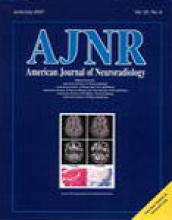Research ArticleBRAIN
Fluid-attenuated Inversion Recovery Intraarterial Signal: An Early Sign of Hyperacute Cerebral Ischemia
Keiko Toyoda, Masahiro Ida and Kunihiko Fukuda
American Journal of Neuroradiology June 2001, 22 (6) 1021-1029;
Keiko Toyoda
Masahiro Ida

Submit a Response to This Article
Jump to comment:
No eLetters have been published for this article.
In this issue
Advertisement
Keiko Toyoda, Masahiro Ida, Kunihiko Fukuda
Fluid-attenuated Inversion Recovery Intraarterial Signal: An Early Sign of Hyperacute Cerebral Ischemia
American Journal of Neuroradiology Jun 2001, 22 (6) 1021-1029;
Jump to section
Related Articles
- No related articles found.
Cited By...
- Ivy Sign in Moyamoya Disease: A Comparative Study of the FLAIR Vascular Hyperintensity Sign Against Contrast-Enhanced MRI
- The Association between FLAIR Vascular Hyperintensity and Stroke Outcome Varies with Time from Onset
- Fluid-Attenuated Inversion Recovery Vascular Hyperintensities-Diffusion-Weighted Imaging Mismatch Identifies Acute Stroke Patients Most Likely to Benefit From Recanalization
- Hyperintense Vessels on T2-PROPELLER-FLAIR in Patients with Acute MCA Stroke: Prediction of Arterial Stenosis and Perfusion Abnormality
- Do FLAIR Vascular Hyperintensities beyond the DWI Lesion Represent the Ischemic Penumbra?
- Hyperintense Basilar Artery on FLAIR MR Imaging: Diagnostic Accuracy and Clinical Impact in Patients with Acute Brain Stem Stroke
- Can Diffusion-Weighted Imaging-Fluid-Attenuated Inversion Recovery Mismatch (Positive Diffusion-Weighted Imaging/Negative Fluid-Attenuated Inversion Recovery) at 3 Tesla Identify Patients With Stroke at <4.5 Hours?
- Clinical Significance of Fluid-Attenuated Inversion Recovery Vascular Hyperintensities in Transient Ischemic Attack
- Hyperintense Vessels on Acute Stroke Fluid-Attenuated Inversion Recovery Imaging: Associations With Clinical and Other MRI Findings
- Hyperintense Vessel Sign on Fluid-Attenuated Inversion Recovery MR Imaging Is Reduced by Gadolinium
- Fluid-Attenuated Inversion Recovery Vascular Hyperintensities: An Important Imaging Marker for Cerebrovascular Disease
- Rescue, Combined, and Stand-Alone Thrombectomy in the Management of Large Vessel Occlusion Stroke Using the Solitaire Device: A Prospective 50-Patient Single-Center Study: Timing, Safety, and Efficacy
- Distal hyperintense vessels on FLAIR: An MRI marker for collateral circulation in acute stroke?
- Angiography Reveals That Fluid-Attenuated Inversion Recovery Vascular Hyperintensities Are Due to Slow Flow, Not Thrombus
- Significance of Susceptibility Vessel Sign on T2*-Weighted Gradient Echo Imaging for Identification of Stroke Subtypes
- Evaluation of Hyperintense Vessels on FLAIR MRI for the Diagnosis of Multiple Intracerebral Arterial Stenoses
This article has not yet been cited by articles in journals that are participating in Crossref Cited-by Linking.
More in this TOC Section
Similar Articles
Advertisement











